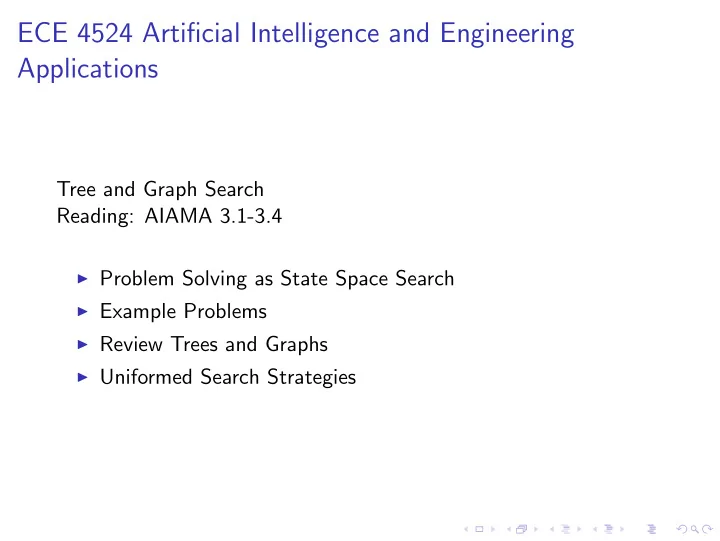

ECE 4524 Artificial Intelligence and Engineering Applications Tree and Graph Search Reading: AIAMA 3.1-3.4 ◮ Problem Solving as State Space Search ◮ Example Problems ◮ Review Trees and Graphs ◮ Uniformed Search Strategies
Problem Solving Agents Problem Solving Agents formulate problems by ◮ representing (model) the world as atomic states , ◮ defining an initial state that represents the initial condition of the world, ◮ defining a goal state that represents what they want the world to look like, ◮ and defining a function for allowable state transitions which map onto actions in the world.
Problem Solving Agent
Example: Sliding Tile Puzzle
Another Example: Peg Solitaire
State space terminology The state space is the collection of the following: ◮ initial state ◮ actions ◮ transition model ◮ successors The problem solving agent searches through this space to find a path from the initial to the goal state.
Tree Search Algorithm
Generalized Graph Search
Data structures supporting search We need a few data structures to implement the graph search algorithms. ◮ Node structure ◮ the state description ◮ a parent pointer or reference ◮ the action applied to get from parent to this node ◮ path cost, the cost of the path from the initial to this node ◮ Function to return successor given state and action ◮ frontier queue (LIFO, FIFO, priority) ◮ explored set (dictionary or hash table)
How to compare specific search algorithms We evaluate and compare algorithms based on the following criteria ◮ Completeness - does it find a solution if one exists? ◮ Optimality - does the solution have the lowest possible path cost? ◮ Time Complexity - how long does it take to find the solution? ◮ Space Complexity - how much memory is needed during the search? The complexity of the graph is summarized by the: ◮ branching factor, b ◮ depth of the closest goal, d ◮ maximum depth, m
Specific Graph Search Algorithms Uninformed search strategies ◮ breadth-first ◮ uniform-cost ◮ depth-first ◮ depth-limited ◮ iterative deepening ◮ bidirectional
Warmup Consider the following graph with initial node A and goal node H. All edges have unit weight. In what order are nodes goal-tested using: 1. breadth-first search 2. uniform cost search 3. depth-limited search with a limit of infinity 4. iterative-deepening search Assume nodes are considered/expanded as action-outcomes using alphabetical order.
Another example Consider the same graph as the warmup, but consider the goal node to be G. All edges have unit weight except the one between D and E, which has a weight of 2. In what order are nodes goal-tested using: 1. breadth-first search 2. uniform cost search 3. depth-limited search with a limit of infinity 5. iterative-deepening search
Next Actions ◮ Reading: Heuristic Search - AIAMA 3.5 and 3.6 ◮ Take warmup before noon on Thursday 1/25. Problem Set 1 has been released - due 2/12/18.
Recommend
More recommend